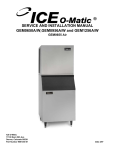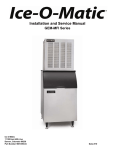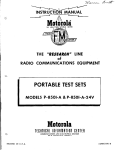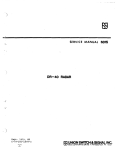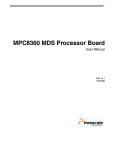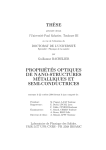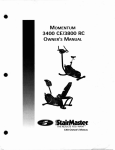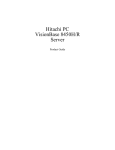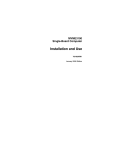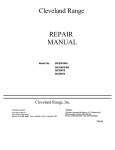Download c - Ansaldo STS | Product Support
Transcript
!UNION SV/ITCH & SIGNALl[ill]
A member of the ANSALDO Group
5800 CorPQrate Onve P1tt>Curgh, PA 15237
SERVICE MANUAL 6236
Installation, Operation and Maintenance
TRU-11 AC TRACK UNIT
100 Hz and 91.67/100 Hz
June,
1984
I 0000440/DN0411 A
A-6/91-2449-3
COPYRIGHT 1989. UNION SWITCH & SIGNAL INC.
PRINTED IN USA
ANSALDO
Trasporti
UNlm~ SWITCH t: SIGNAL
CONTENTS
Sc:C'!'ICN
PAGE
I.
GENERAL INFORMATION
1/2
1.1
1.2
INTRODOCTION
EQUIPMENT SPECIFICATIONS
1/2
1/2
II.
INSTALLATION
3
2.1
2 .2
PR:>CEWRES
UNIT OPERATING FREQUENCY CONVERSION
3
4
III.
PRINCIPLES OF OP~RATION
7
IV.
MAINTENANCE AND TEST
4.1
4.2
4.3
4.4
GENERAL
PROCEDURES
11
11
11
12
FIELD CHECKS
OPERATIONAL {SBJP) TESTS
{SIDP) TESTS
16
CCM?ONENT
APPENDIX A - PARTS LIST
LIST OF ILLUSTRATIONS
Figure 1.
Figure
Figure
Figure
Figure
Figure
Figure
Figure
Figure
Figure
Typical Track Circuit for 100 Hz
TRU-II Steady Energy Signal - AC
2. Typical Track Circuit for 100 Hz
TRU-II Steady Energy Signal - 0:
3. TRD-II Circuit Diagram
4. V-I Characteristics
s. Test Set-up
6. Tuned Circuits Test Set-up
7. Oscilloscope Trace
s. Transformer Test Set-up
9. unit U Subassembly Test Set-up
10. Signal Voltage Waveform
and 91.67/100 Hz
Traction Only
and 91.67/100 Hz
Traction Only
5
6
8
9/10
15
19
20
23
27/28
27/28
i
R~
~
UNION S"r\'ITCH & SIGNAL
Typical TRU-II Rack Installation
ii
SECTION I
GENERP.L INFORMATION
1.1
INTRODU:TICN
This manual contains ~~e operation, installation and maintenance procedures for
the TRU-II 100 Hz unit N451206-0101, the 91.67/100 Hz {91.67 Hz) unit
N451206-0103, and the 91.67/100 F.z (100 Hz) unit N451206-0l05.
TRIJ-II is designed to replace all models of the cen tr ::.fugal trac~ relay. Its
primary use is in steac.y energy track circ·Jit applications in ac propul.:::.on
territory. When used in conjunction with a TRIJ-II Code Reset U:-1it. {Se:·.':'..ce
Manual 6237), the TRU-II may also be applied in single or double direction code
overlay applications.
When a track circuit is operating properly, the relay driven by TRU-II will be
energized. Track occupancy or system failure will cause the relay to release.
The 100 Hz and 91.67 Hz/100 Hz ·:::ru-II units are plug-in packages. These units
are mounted on standard relay e-..,lipment racks along with their associated
relays.
In situations where a wire for wire replacement for a shelf nounted
centrifugal relay is desired, a number of mini-racks including TRIJ-II, relays,
and associated components are available.
l .2
EQUIPMENT SPECIFICATIONS
TRU-II Outp.1t Relay:
PN-lSOBH, N3225ll-003
Local Voltage:
110 V or 120 Vac +10%
Local Cur rent.:
50 Ma Range
Track Voltage:
10 Vac Range
Track Current:
100 Ma Range
Dielectric Breakdown Voltage:
Operating Temperature Range:
Overall Dimensions:
Mounting:
3000 V, 60 Hz for one minute
-40°c to 70°c
H=Sn, W=4-15/16", D=9-l/2"
Standard Equipment Rack
Traction Power Environment:
Harmonic Imnunity:
tC to 60 Hz AC
91.67 Hz unit is immune to 100 Hz
(Fourth harmonic of 25 Hz traction po1io1er)
6236, p. 1/2
UNION S"iHITCH & S!GNAL
SECTION 11
INSTALLATION
2.1
PROCEDURES
For the prope= installation of TRU-II refer to Figure 1 or 2 and the appropriate
track circuit adjustment table. Proceed as follows.
WARNING
MAKE CERTAIN THAT SIGNAL AND OPERATING POWER TO 'lHE TRU-11
UNIT REMAINS OFF UNTIL ALL INSTALLATION PROCEDURES ARE
COMPLETE. O'IHERWISE PERSONAL INJURY MAY RESULT.
a.
Install and connect the track circuit feed equipment as shown on Figure
l or 2 using the proper settings of the feed transformer, and the feed
resistor and or reactor as required (see track tables).
b.
Install and connect the track input fuse block and W-400 step-up
transformer. Install and connect the local fuse block as shown.
Attach a warning label adjacent to the track fuse block with arrows
pointing toward the fuse as shown below.
t
WARNING
THIS FUSE IS PART OF A
VITAL SAFETY CIRCUIT.
REPLACE WITH 3 AMP
t
BUSSMAN KAB-3 ONLY.
t
WARNING
t
THIS FUSE IS PART OF A VITAL
SAFETY CIRCUIT. REPLACE WITH
1;. AMP BUSS MAN KT K • '~ 0 NL Y
c.
For AC Traction
Applications
(M451607-6102)
For DC Traction
Applications
(M451639-1101)
When mounting TRU-II in our standard equipment rack, bolt the mounting
base plate in position beside its associated PN-lSOBH relay base.
NOTICE
'IHESE
UNITS MUST BE MOUNTED SIDE BY SIDE.
1.
Solder connect the track signal lines from the receive transformer
secondary winding to TRU-II socket terminals land 2, observing
the polarity as shown.
2.
Solder connect the local signal lines (110-120 Vac) to TRU-II
socket terminals 3 and 4, observing the polarity as shown.
6236, p. 3
ffi
ffi
1.JNION SWl7CH & SIGNAL
3.
d.
Solder connect the PN-lSOBH relay de signal lines to TRU-II socket
terminals 7 and 8, observing the polarity as shown.
When shelf rrounting (direct wire for wire replacement of cent:ifugal
relays), place mini-rack c:t desired locatior1 and bolt to shelf.
Plu;-in TRU-II, P~-lSOBH relay an:i its relay repea-cer.
l.
Connect the track signal lines from the track transformer
secondary winding terminals to the mini-rack terminals labeled lT
ard 2T, observing the polarity shown on Figure l or 2.
2.
Connect the lcx:.:al signal lines (110-120 Vac) to the mini-rack
terminals labeled Ll and L2, observing the polarity shown on
Figure l or 2.
e.
Plu;-in the proper lcx:.:al fuse (l Amp, Bussman NON l).
£.
Plug-in the proper track fuse (3 Amp, Bussman KAB-3 for AC traction) or
(1/4 Amp Bussman KTK-1/4 for 0: traction)).
WARNING
'lHE TRACK FUSE! MUST BE OF 'lHE CAPACITY AND TYPE SPECIFIED.
ANY StBSTITUTION MAY CCMP R)MISE '!HE SAFE PERFORMANCE OF
'lHE TRACK CIRCUIT.
g.
2 .2
Correct phase relation is necessary ard is obtained by observing the
proper polarities at the transmitting and receiving ends of the track
circuit as shown on Figure l or 2.
UNIT OPERATING FREQUENcY CONVERSION
N:>TE
The conversion of a 91.67/100 Bz TRD-II unit from
91.67 Bz operation to 100 Hz operation or the
conversion from 100· Hz to 91.67 Hz operation requires
the unit to be shopped.
to 91.67 Hz operation (N451206-0103) the lead wires to
inductors Ll, L2 aoo L3 are to be connected to terminals A aoo c.
a.
To conver t
b.
To convert to 100 Hz operation (N451206-0105) the lead wires to
inductors Ll, L2 aoo L3 are to be connected to terminals A aoo B.
c.
The name plate on the front cover should be turned (two sided name
plate) to reflect the correct operating frequency ar:o part number.
d.
After a frequency conversion is completed, the TRD-II unit must be
tested to comply with the operational (shop) specifications.
6236, p. 4
-·---·-- -- ·-~---··------
.
TRANSMIT END
RECEIVE END
+
+
+
'kl
---'Id
111,
*3A•·
.r,
'I
W-400
B
TRACK
TRANSFORMER
1:10
+1P
MINI-RACK
TERMINAL BOARD (WHERE APPLICABLE)
-
-
2P
1T -
-
TRACK
INPUT
--).,_:T_ -
--,
LC •. AL
INPUT
2
IA
3
+
91.671100 Hz
NX 110·120 VAC
4
TRU:I[
W-400
TRACK
TRANSFORMER
BX
100 Hz OR
~
11
8
r
+IP
I
---
TA~l[
T
I
--'
TRU-Il.
-OUI
+OUT
I
3A
+I
I
I
I
110-120 VAC
I
I
NX
I
I - ,
I
PN-150BH
I
L-------------,
812
3
6>--- I
r,
* SPECIAL
FUSE
NOTICE
THIS FUSE IS PART OF A
VITAL SAFETY CIRCUIT.
REPLACE WITH 3 AMP.
BUSSMAN KAB-3 ONLY.
I
+
}_-J
PN-1508
OR
PN-2508
I
:
I
I
:::j
I
I
c
0
z
~
z
0
N12
I
:z:
11,0
(/J
ci
:z
)>
r
Figure 1.
Typical Track Circuit for 100 Hz and 91. 67/100 Hz
TRU-11 Steady Energy Signal - AC Traction Only
ffi
TRANSMIT END
e3
RECEIVE END
+
c
z
0
z
~
0\
tJ
w
.
0\
.
'O
+
+
:V..I
:v.1
-I
Ill•
n
:c
0\
W-400
TRACK
TRANSFORMER
z
B
1:10
""
(/)
6
z
)>
r-
* 1/4A
MINI-RACK
TERMINAL BOARD (WHERE APPLICABLE)
-
-
TRACK
INPUT
2P
+1P
2T
-
----,
3
100 Hz OR
91.67/100 Hz
TRU·II
+
W-400
TRACK
LOCAL
INPUT
2
1A
L·1
BX
NX 110·120 VAC
4
___ _
e
TRANSFORMER
I7
-----'
TRU·lI
r;u.JI
+1P
I
3A
-OUT
tOUT
I
I
+
A 1-+I B
I
110-120 VAC
I
NX
I
PN·150BH
I
r,
L - - - - - - - - - - - - - -,
-J I 1_J +
* SPECIAL FUSE
L__l
NOTICE
THIS FUSE IS PART OF A
VITAL SAFETY CIRCUIT.
REPLACE Wint 1/4 AMP.
BUSSMAN KTK-1/4 ONLY.
Figure 2.
012
3
PN-1508
OR
PN-2508
I
I
I
I
N12
Typical Track Circuit for 100 Hz and 91.67/100 Hz
TRU-11 Steady Energy Signal - DC Traction Only
UNION SWITCH & SIGNAL
SECTION III
PRINCIPLES OF OPERATION
The TRU-II circuit, including subunit ide~tity is shown on Figure 3. Input from
t~~ local signal lines, VLl (110 Vac R~) is co~~ecterl to the primary of
Transformer T2. Transformer T2 is a saturable transformer, which in conj unction
wit..'l the series tuned circuit consisting of indoctor L2 and capacitor C2, acts
as a voltage regulator, a phase shifte:: (630 lag}, an input filter and an
isolation transformer. The track input VTl (10 Vac RMS range-output from W-400
1:10 track step-up transformer) is connected to step-up transformer Tl through
t.1e series tuned filter consisting of inductor Ll and capacitor Cl. This filter
prevents track input noise and traction power from influencing circuit
performance. T....o MOV varistors, Vl aDi V2, are connected across the secondary
of t.:::ansformer Tl in the form of a four terminal network which in conjunction
with Ll and Cl provides voltage limiting for track input signals. To swamp out
the non-linear loading influence of varistor V3, a heavy shorted turn is
incocporated into this transformer to present a low impedance load.
The transformer output signals VT2 aoo VL2 are series connected and form the
drive source for the remaining passive circuit. This circuit includes a noise
rejecting series tuned bandpass filter consisting of capacitor C3 and inductor
L3. A varistor V3, a full wave rectifier, an instrument fuse, and a relay load
complete the circuit loop.
The V-I characteristics of the series connected components, varistor V3, diode
bridge rectifier, series tuned circuit, fuse and relay load is illustrated on
Figure 4. In the presence of lee al input only, the out?}t of Transformer T2
secondary (VL2) is applied to the circuit loop and produces a small current
output vector (well below the relay pick-up level) as shown. When a track input
of about equal amplitude at Transformer T2 secondary (VT2) is applied in phase
with VL2, the two voltages add in phase and produce a large current vector as
shoW1. As a result of the non-linear circuit transfer characteristics, adding
two in?}t voltage vectors, produces a total current roughly proportional to
their voltage product. Th is calculation is performed similar to the
manipulation of a conventional slide rule. The actual current through the
biased relay is pulsed a: produced by the full wave rectifier.
The instrument fuse is to provide protection for varistor V3. Under normal
operating conditions, this fuse canrx>t be blown, regardless of the signal
ampli~ude level or frequency that is applied to the TRU-II local or track
inputs. Capacitor C4 provides for transient suppression. Transformers Tl and
T2 are provided with multiple taps to provide for shop calibration.
The dashed windings on inductors Ll, L2 and L3 apply to the 91.67/100 Hz TRD-II
units only. When these TRU-II units are to be adjusted for 91.67 Hz operation
(N451206-0103}, the inductor connections are made to terminal C. When these
TRU-II units are to be adjusted for 100 Hz operation (N451206-0105), the
indoctor connections are made to terminal B.
There are no TRU-II internal or external adjustments for track length
ccmpensation. All track adjustments are made at the track feed eoo.
6236, p. 7
S3
EB
C\
tJ
w
a,
.
r----------,
.
'O
r - -
I
UNIT 1
a,
T1
ev1
~NI;; - - -1
I
I BA : c ~ /
3
V2
I
MATCHED
PAIR
TRACK INPUT
10 VAC • 100 Hz (91.67)
(
, -0-,
-
4
{
LOCAL INPUT
10 VAC • 100 Hz (91.67)
--<<
3
I
II
I
I
I
-« ;
8
1
y
BU
I
L
-~
_o!_ _s~_J
-
BJ ~
. 2
MATCHED
T2
PAIR
.
11
·~" ·3
BK •
--------A·
I
I
A
_JI
W.
BK
0
+
PN-150BU
RELAY
,
Fl
I
C2
BK
I
I
I
I , TL4
I
~
UNIT2
PCB
I
~-
I1
VL1
------,1
Ir
VTI
I
I
I
I
I
I
I
I
I
I
I
TL1
:I
1L.:.. _ _ _ _ _ _ _ _ _ _ _JI
C4
I . (
L_ _ _ _ _ _ _ _ _ J
L __
Figure 3.
TRU-11 Circuit Diagram
c
z
0
:z
~-i
()
::c
Qt
Ill
Cl
z
)>
r
UNION SWITCH & SIGNAL
+I
I
---+
VL2
-
---+.
Vr2
Figure 4.
V-I Characteristics
6236, p. 9/10
UN!ON SWITCH & SIGrlAL
SECTION 'IV
MADrrENANCE AND TEST P RO:E CURES
4 .l
GENEP.AL
Init:.ial checks of the 100 Bz or 91.6i ~.CO Hz TRU-II consists of voltage readings
taken across selected external terminals.
A TRU-II unit suspected of being defective should be replaced with one known to
be in working order.
If a unit is found to be defective, it should be shopped
for repair or returned to OS&S for repair or replacement.
No TRIJ-II unit field repairs should be attempted.
WARNING
EXTREME CARE SHCXJLD BE EXER:ISED DURING "POWER-ON" TESTS
OF '!'HE TRU-II UNIT. CONTACT WI'IB 'IEE UNIT TERMJN~S MAY
RES ULT IN PERSONAL INJURY.
4 .2
FIELD CHECKS
The TRIJ-II, like all vital safety devices, must be field
tested periodically to ensure safe operating limits. We
reconmend that it be tested every two years. If the unit
does not perform as specified, the unit should be replaced
and the faulty unit returned to the shop for repairs.
a.
Bequired test equipment:
ohm/volt).
Simpson 260 Analyzer (or equivalent, 20,000
b.
Check that the TRU-II unit and associated equipment is properly
installed, including the condition and tightness of all terminal
connections.
c.
Measure the voltage across the TRU-II track input socket terminals 1
and 2.
(When applying mini-racks, measure this voltage between rack
terminals Tl and T2.) The voltage should be steady energy 100 Bz
(91.67 Hz) at about the 10 to 15 Vac RMS level when the track circuit
is not shunted.
d.
Measure the voltage across the TRU-II local input socket terminals 3
and 4.
(When applying mini-racks, measure this voltage between rack
terminals Ll and L2). The voltage should be steady energy 100 Hz
(91.67 Hz) at about the 110 to 120 Vac RMS level.
6236, p. 11
ffi
UNION SNITCH & SIGNAL
e.
Measure the voltage across the TRIJ-II output socket terminals 7 and 8.
(When applying mini-racks, measure this voltage between rack terminals
designated TRU-11 + Out and TRU-lI - out). The output voltage is pulsed
de which should read an average voltage of 12 to 16 Vdc when the track
circuit is not shunted.
WARNING
ACCIDENTLY SHORTING 'IHE TRU-II OUTPUT TERMINALS MAY BLOW
THE TRU-11 INI'ERNAL INSTRUMENT FUSE.
REPLACEMENT OF THIS
EUSE REQUIRES SHOPPING THE UNIT.
f.
4. 3
Remove the 3 amp. track fuse and, using the Simpson 260 multimeter
adjusted to the 10 volt scale, measure the TRU-11 output voltage across
output socket terminals 7 and 8. (When applying mini-racks, measure
this voltage between rack terminals designated TRU-11 + out and
TRU-11 - out.) The output level should not exceed +2.5 volt de.
OPERATIONAL (SHOP) TESTS
NOTE
Shop tests must be performed on all TRU-11 units sent to
the shop for repair or spec. verification before returning
them to service.
a.
Required test equipment (or equivalent):
o
Voltmeter (Vl), ac, 0-150V, Fluke 8050A Digital Multimeter
o
Voltmeter (V2), ac, 0-30-60V, Weston 433-1913004
o
Milliammeter, ac, 0-75 Ma, Weston 433-4913005
o
Voltmeter (V3), de, 0-30V, Weston 931-1916003 (5000 ohm/volt)
o
Hewlett-Packard frequency meter made up of H.P. 5300 measuring
system and a 5307A high resolution counter
o
Wavetek 115 oscillator
o
Mcintosh 2100 audio amplifier
o
Four l.5K, 25 watt resistors
o
Two variacs, General Radio SA
o
One US&S W-400 Transformer, Type N451428-0101
o
Miscellaneous switches shown on Figure 5
6236, p. 12
UNION 51.~.'ffC,-i & SIGh:/. _
b.
o
Three phase "Yq connected Electronic Power Supply Generator 4=0
V.A., 150 VA per phase 0-130V, 1.2 ar:ips per phase, Behlman
Engineering Corp., Mod. 3-10-C-D. Behlman plug-in oscillator Mod.
OSCD-3-45/200-G
o
One US&S PN-lSOBH Relay. Type N3225ll-003
Wiring ar.d Level Adjustment Test
1.
Connect test instrumentation as shown on Figures. Note the phase
arrangement cf the three phase power source. Phase 2 lags Phase 1
by 120° and.Phase 3 lags Phase 2 by 1200.
2.
Put the inverter switch in the invert position, the phase select
switch to position 3, the track input switch to normal and the
interference frequency switch to the "off• position.
3.
With the power supply level set to zero, turn the output switch on
the power supply to the "ON" position. Adjust the power source
frequency to the value required (Table 1) for the TRU-11 rno<lel
being tested.
CAUTION
'lhe Electronic Power Supply should have its output level
set to zero before turning the input power "on" or "off"
to avoid possible equipment damage. See power supply
instruction manual.
4.
Adjust power supply voltage level to 110 Vac as
voltmeter Vl across the local input. Adjust tl
track input voltage indicates 10 Von voltmeter
output voltage indicated on voltmeter V3 should
l tern 1, Table 1 •
S.
If the TRU-II de output level is outside the spec. range, it may
be adjusted by referring to Figure 3 and the following tabulation.
TRU-11 Ou~put Level
Low
Med.-Low
Med. -High
High
indicated by
variac so that the
V2. The TRU-11
read as shown on
Transformer T2 Secondary Taos
B &c
B &D
A&c
A & D
6236, p. 13
L:NICN SWITCH & SIGNAL
c.
d.
e.
Regulation Test
1.
Leave all switch and level settings the same as in Section 'b'
above. The local input current and TRU-1! output voltage should
equal the values shown on Table l, Item 1.
2.
When the power source level is increased to 130 volts and the
track level is adjusted to 11 volts, the local current and output
voltage should equal the values shown on Item 2, Table 1.
3.
When the power source is decreased to 90 volts and the track level
is adjusted to 9 volts, the local current and output voltage
should equal the values shown on Item 3, Table 1.
Track Phase Test
1.
Leave all switch and level settings the same as in Section 'b'
above. Adjust the power source to 110 volts.
2.
Using variac tl adjust the track input voltage to a level which
results in a TRU-II de voltage output level of 10.0V.
3.
Turn the inverter switch to the normal position and th phase
select switch to position 1. 'lbe TRU-II output voltage should
equal the value shown on Item 1, Table 2.
4.
Turn the phase select switch to position 2.
equal the value shown on Item 2, Table 2.
'lhe output should
5.
Turn the phase select switch to position 3.
equal the value shown on Item 3, Table 2.
The output should
Track Input Limiter Test
1.
Leave all switch and level settings the same as in Section 'b'
above. Adjust the power source to 130 volts.
2.
Turn the track input switch to the overload position and adjust
the track input V2 to 22 volts. 'lhe TRU-1! output voltage should
equal the value shown on Table 3.
6 236 I P• 14
~ .
UNION SWITCH & SIGNAi.
3 PHASE GENERATOR OR
ELECTRONIC
POWER SUPPLY
TRU-11
+r------.+
1(A)
a..-------~t------------:>UT PUT
A
LOCAL
INPUT
DC
7...,..........--,1~-------
3 2
+
+
TRACK
INPUT
1
\
,
3
,
PN·150BH
PHASE
\ SELECT
SWITCH
[Jo;
INV.
(PH3)
(INV.)
INVERTER
SW.
. NORM.
~
(B)
A
#2 VARIAC
I
PH2
INTERFERENCE
FREQ. SW.
I
\
\
(A)
OFF
PH1
PHASE
RELATION
(C)
PH3
GND. SIDE
TRACK
INPUT
SW.
OVERLOAD
A
OFF
B
D
W-400
TRANS.
16
AUDIO
AMP.
COM.
FREQ.
METER
3P
osc
Figure 5.
Test Set-up
6236, p. 15
U,
UNlON SWITCH & SIGNAL
f.
Traction Current Safety Test
l.
2.
g.
h.
Leave all switch and level settings the same as in Section 'b'
al:::ove. Place the track input switch to the •off" position and the
interference frequency switch to the •on• position.
With variac.t2 connected as shown on Figure 5 and set to zero,
increase the variac output so that the track input voltage reads
50 volts. The TRU-ll output equal the value shown on Item 1,
Table 4.
Traction Current Imbalance Tolerance Test
1.
Leave all switch and level settings the same as Section 'f'
above. Adjust variac 12 so that the track input reads 50 volts.
2.
TUrn the track input switch to normal.
read as shown on Item 2, Table 4.
'!he TRU-Il output should
100 Hz Safety Test (For 91.67 Hz Unit Only)
1.
Leave all switch and level settings the same as Section 'g'
al:::ove. In place of 12 variac, connect the audio oscillator and
amplifier shown on Figure 5.
2.
Using a frequency meter, adjust the oscillator frequency to 100.0
Hz.
3.
Increase the amplifier output voltage until the track input V2
reads 50 volts. The TRU-Il output should read as shown on Item 3,
Table 4.
5.4. COMPONENI' (SHOP) TESTS
a.
General
Tests on individual subassemblies and components of the 100 Hz and
91.67 Hz TRU-II requires removing the cover and disconnecting the unit
from all external connections. Make certain during reassembly that all
parts and wiring connections· are returned to their correct locations.
NOTE
When assembly is complete, the unit must be subjected
to the tests described in Section IV (Operational
Tests) before the unit is put back into service.
Refer to TRU-11 general drawing on Figure 3.
6236, p. 16
\
UNION SWITCH & SIGNAL
Table 1.
.?ower
Source
Freq.
Item
No.
Hz
Wiring and Regulation '!'est
Power
Source
(Local)
VAC (RMS)
Track
Input
VAC {RMS)
Local
Input
Current
Milli amps
TRU-Il
Output
V.D.C.
l.
100.0
91.67
110.0
110.0
10.0
10.0
42-58
42-58
13 - 15
13 - 13
2.
100.0
91.67
130.0
130.0
11.0
11.0
45-62
45-62
13.5-15.6
13.5-15.6
3.
100.0
91.67
90.0
90.0
9.0
9.0
38-53
38-53
12.1-:!.4.0
12.1-14.0
Table 2.
I
Item
No.
Track Phase Test
Power
Source
Freq.
Phase
Select
Switch
Position
Hz
TRU-Il
Output
V.D.C.
l.
100.0
91.67
1
7.0 - 8.3
7.0 - 8.3
2.
100.0
91.67
2
6.0 - 7.5
6.0 - 7. 5
3.
100.0
91.67
3
0.5 - 2.0
o.5 - 2.0
Table 3.
Power
Source
Freq. Hz
100.0
91.67
Track Input Limiter Test
Track
Input
VAC
(RMS)
22
22
TRU-11
Output
V.D.C.
15 - 19
15 - 19
6236, p. 17
ffi
ffi
UNION SWITCH & SIGNAL
Table 4.
Power
Sourc~
Freq.
Hz
Track
Freq.
Hz
1.
100.0
91.67
60
60
so.a
so.o
3.0 - 6 .o
3.0 - 6.0
2.
100.0
60
100
50.0
10.0
10.5 - 14.5
91.67
60
91.67
so .a
10.0
10.5 - 14.5
91.67
100.0
50
Item
No.
3.
b.
Traction Current Safety ~est, Traction
C..irrent Imbalance Test and 100 Hz Safety Test
Track
Input
VN:.
(R~S)
TRU-Il
Output
v.o.c.
7.0 - 9.5
Test Procedure for TRII-Il Series Tuned Circuits
l.
Required test equipment (or equivalent):
Hewlett Packard 200AB Oscillator,
Tektronix 434 two channel oscilloscope,
Decade Resistor Box 0-100 ohm, +5%,
Decade Resistor Box 0-lOK ohm, ±5%,
Amplifier, Mcintosh 2100,
Hewlett Packard High Resolution Frequency Counter 5307A,
Digital Ohnmeter, Fluke BOSOA multimeter.
2.
Measure an inductor's de resistance value and compare it to the
value listed on Tables.
3.
To perform an operational test on a tuned circuit, electrically
isolate the circuit from its surrounding circuitry by
disconnecting the lead wire shown on Table 5 and connect the tuned
circuit (inductor-capacitor combination) into the test circuit
shown on Figure 6.
4.
Adjust both oscilloscope trace lines so that their ground levels
are on the middle horizontal line.
5.
Adjust the decade resistor to the required value shown on Table 5.
6.
Adjust the input voltage to the level shown on Table 5.
this level throughout the test.
6236, p. 18
Maintain
UNION SWITCH & SIGNAL
OSCILLATOR
FREQUENCY
COUNTER
SCOPE
+
+
GND.
BJ'\.INPUT
COMMON
CHANNEL
CHANNEL
1
AMPLIFIER
2
c
SERIES
DECADE RESISTOR
NOTE:
EXTRA TURNS
ON INDUCTORS
Figure 6.
NOTE:
ON PART NO'S N451207-0601
AND ..()602, CONNECT SERIES
DECADE RESISTOR TO
TLA ON PCB.
Tuned Circuits Test Set-up
6236 I P • 19
83
B3
UNION Sr'IITCH & SIGNAL
7.
Adjust the oscillator frequency so th at the oscilloscope tr ace
appears as shown on Figure 7. The tuning point should be within
the frequency ra(Y:3e shown on Table 5.
On un.:.~s N451207-0502, 0602 and 0702 connect the full
inductor winding for test purposes.
If an inductor or capacitor is found to be defective,
both must be replceed since they are assembled and
tested as a matched pair.
WHEN NETWORK IS PROPERLY TUNED ,
BOTH TRACES CROSS AT THE SAME POINTS
Figure 7.
6236, p. 20
Oscilloscope Trace
(
Table 5
DC
Subassembly
Unit No.
Disconnect
Lead Wire
For Teat
Realatance
Start to
Inductor Tap
Mln.
Max.
Real stance
Start to End
Hln.
Max.
Oh11a
Ohlla
DC
Tuning Pt.
LC Network
Start to
Inductor Tap
Hln.
Max.
Hz
Tune Pt.
LC Network
Start to Bnd
Hln.
Max.
Hz
Resistance
Level of
AC Input
Chl
of Ser lea
AC
Output
Cl2
Decade
Res ls tor
11
N451207-0501
Red
no tap
18.9
20.9
no tap
100.2
101.8
22.4Vp-p
11.o-12.2v.P.P.
45 ohms
ll
N451207-0601
Brown
no tap
119.5
131.5
no tap
102.2
10].8
40Vp-p
21.5-30.SV.P.P.
2K ohms
12
N451207-0701
Yellow
no tap
50.6
55.6
no tap
92.0
93. 6
30Vp-p
11.4-14.0V.l'.P.
lK ohms
11
N451207-0502
Red
18.9
20.9
20.5
22.9
100.2
101.8
91. 5
93.5
22.4Vp-p
11.o-12.2v.P.P.
45 ohms
13
N4 51207-0602
Brown
119.5
131.5
llO
lU
102.2
10].8
93.5
95.5
40Vp-p
27.5-30.5V.P.P.
2K ohms
12
N451207-0702
Yellow
50.6
55.6
55
60.8
92.0
9].6
83.7
85.7
30Vp-p
11.4-14.0V.P.P.
lK ohms
I
0\
N
c
z
0
z
w
I::::j
.
...
0
0\
'U
N
x
ti"
(ti>
G>
z)>
r-
EE
IJNlON SWITCH & SIGNAL
c.
Test Procedure for TRU-II Transformers
l.
Required test equipment (or equivalent):
Wavetek 115 Oscillator,
Tektronix 434 t-...o channel oscilloscope,
Decade Resistor Box 0-100 ohm, .:!:,5%,
Decade Resistor Box 0-lOK ohm, ±_5%.
2.
Measure the transformer primary am secondary winding resistances
and compare them to ~~e values listed on Table 6.
3.
To perform an operational test on a transformer, electrically
isolate it from its surrouming circuitry by disconnecting one e!'ld
of the slate lead wire connecting the transformer secondary
wiooings. Then connect the transformer into the test circuit shown
on Figure a.
4.
Adjust Rl aoo R2 to the values shown on Table 6. Adjust the
oscilloscope frequency to 100 Hz and its output voltage level to
the value shown on Table 6.
5.
Using an oscilloscope, measure the voltage level across Rl, Coil A
and Coil B. The waveforms in all cases should be harmonic free
sinewaves. The signal voltage amplitude should be within the range
sho\<l'l on Table 6.
NOTE
There are two varistors connected across the secondary
coil of Transformer Tl. These varistors (a matched
pair) are connected in a four terminal safety
circuit. If one varistor is found to be defective,
both var is tors must be replaced. See the matched pair
ordering number on the parts list. When varistors are
replaced, the wiring and component connections must be
exactly the same as the original with no alterations.
The varistors on the secondary of transformer should
not influence the resistance or voltage tests since
their resistive load is negligable at the test voltage
levels. If the transformer voltage measurements are
not correct, disconnect one side of the varistor which
is connected to coil terminals A am B and repeat the
transformer test.
6236, p. 22
UNlC' SWITCH & SIGNAL
OSCli.LAiOR
R1
''
T +_
COMMON
___.
s
0
''
SHORTED TURN FOR
''
N451039-4101 ONLY
'
COIL A
'
',
PRIMARY
0
'
COIL B
no
SECONDARY
0
0
/
/
/
/
R2
Figure 8.
d.
83
Transformer Test Set-up
Test procedure for track input varistor limiter.
1.
Required test equipment (or equivalent) same as Section 'c'.
2.
Inspect both t~ack input limiter varistors (Vl and V2) for
mechanical dar _,ge.
3.
Check all varistor electrical connections.
4.
To electrically test the track input varistor limiters, isolate
Transformer Tl from the unit by disconnecting the slate wire on
terminal D of the secondary winding.
5.
Connect the transformer into the test circuit shown on Figure 7.
6.
Adjust Rl and R2 to the values shown on Table 6 (Tl with varistor
limiters). Adjust the oscillator frequency to 100 Hz and its
output level to the value shown on Table 6.
7.
Using an oscilloscope, measure the clipped peak-to-peak voltage
ac:oss coil B. The voltage level should be within the :ange shown
on Table 6.
6236, p. 23
EB
c
(l'l
z
z
N
i5
w
<1•
~....
'c:l
n
Table 6
:c
I!>
N
(I)
""'
ci
z
)>
Transformer
No
Tl
N451039-4101
Tl
N451039-4101
(With
Var is tor
Limiters)
T2
N451039-4102
Coil Res.
Coil A
(Primary)
(Ohms)
Coil B
(Secondary)
Term
A to D
3.17 To
2.87
Term
A to B
164 To
148
--
-
Term
A to B
2, 60 To
2. 34
.
Term
A to D
2.94 To
2. 66
Rl
Ohms
R2
Ohms
Osc. Out
Volts
P-P
Rl
Volta
P-P
Coil A (Pr 1.)
Connections Volta
P-P
6.9
50
6,000
15
7.6
so
6,000
--
30
2,000
30
To
20.3
To
A & B
8.5
To
53
66
B &C
A &B
To
80
18.9
2,000
48
7.8
B &C
To
Coil B (Sec,)
Connections Volts
P-P
9.5
9.4
A &B
To
11.8
A &C
1'o
10.5
I
r
UNION S\'YITCH & SlGiUL
NOTE:
The t=~nsformers secondary wirxlings as shown in Figure
3 ap:=' r to be connected in opposing phase. This is
interi.::d so that the saturable transformer T2, which·
prov icas a very large phase lead, and Transforr.ier Tl
have ::.:.-;e proper phase relation to each other.
e.
Test am adjustment procedure for
:.it 1 subassembly.
This ?t:ocedure must be followed when any component in
Unit 1 subassembly is replaced.
1.
Required test equipment (or equivalent):
Voltmeter, ac, (Vl), Fluke 8050A Digital Multimeter,
Milliamneter, ac, 0-150 Ma, Weston 433-4913005,
Voltmeter, ac, (V2), Fluke 8050A Digital Multimeter,
Frequency Meter Hewlett Packard 5300 with 5307A,
Oscillator, Wavetek 115,
Audio Amplifier, Mcintosh 2100,
Decade Box 0-lOK Ohms, ,±.5%.
2.
Disconnect the slate wire on Terminal D of Transformer Tl secondary
winding and connect the test instrumentation as shown on Figure 9.
(The primary connections to Transformer Tl will vary depending on
original calibration.)
3.
Adjust the frequency to 100 or 91.67 Hz as required, the resistance
of R to 4. SK and Vl to 9 .O Vac RMS.
4.
The input current should read within the 94-102 Ma.
range. The output voltage, V2 should read within the 27.4
- 33.6 volt range.
5.
If the current ·level is outside the 94-102 Ma. range,
adjust the wire to the tap connections according to t.rie
following list.
Cur rent Level
Highest
High
Medium
LOw
f.
Blc:Ck Wire
B
B
A
A
Green Wire
c
D
c
Taps
D
Test procedure for printed circuit board.
6236, p, 25
:t1
llJ
ffi
UNION SWITCH & SIGNAL
Required test equipment (or equivalent):
Decade Resistor Box 0-lOK Ohms, ~5%,
DC power supply, 0-50 Volt with coarse and
fine level adjustment,
Oscillator, Wavetek 115,
Oscilloscope with de capabilities,
Digital Multimeter, Fluke 8050A
1.
Inspect the board for damage and loose solder connections.
2.
Disconnect the white wire from TL2.
3.
Connect the oscillator output to turret lugs TL2 and TLS of the
PCB. Connect a 2K resistor load across TLl and TL3. Adjust the
oscillator output to 1000 Hz frequency and 30 volts p-p.
4.
With the oscilloscope ground connected to TLl, measure the signal
voltage across TLl and TL3. The signal should appear similar to
Figure 10 and its amplitude range should be 1.8 to 3.4V p-p.
NOTE
When testing the printed circuit board do not grossly
exceed the 30 V p-p test input, since doing so may
bla... fuse Fl. Be sure that the oscillator output is
not connected to ground via the ground strap.
5.
Disconnect the oscillator and oscilloscope. Do not disconnect the
2K resistor from TLl and TL3. Connect the SO volt de power supply
output across TL4 and TL2. Do not turn on power supply. Connect
the dig ital voltmeter across·· the 2K resistor TLl and TL3. Adjust
the power supply output to the minimum level. Turn on the supply
and slowly increase the output voltage until the voltmeter reads
20.0 +0.1 volt. Measure the voltage across varistor V3 by
connecting the digital voltmeter to TL2 and the cathode (side with
the black stripe) of diode D3. The output voltage should range
from 23.0 to 31.l volts.
~
6.
Connecc the de power supply and the 2K resistor as in Test No. 5
above. Connect the digital voltmeter to TL2 and the cathode of
D3. Adjust the power supply so that the voltmeter reads 20.25 +
0.1 volts. Measure the voltage across the 2K resistor. This
output should read in the Oto 1.8 Vdc range.
NOTE
When replacing Fuse Fl, allow 1/4• lift-off from the
printed circuit board. Fuse Fl is part of a vital
safety circuit. Replace with a 1/64 amp. J710143 fuse
only. lf fuse Fl is open, replace it and perform a
complete TRU-11 operational (shop) test.
6236, p. 26
UN,::.:N SWITCH & SIGNAL
OSCf!.LATOR
AUO!O AMPLIFIER
8 J'\.
FREQ.
METER
COM.
,.-------------•
c
----i
1
I
I ,,,,,,.
,,, ,,,
I
I
, ' IREo 8
I
I
I
I
I
I
I
I
I
I
I
L-------,
I
GREEN
R
IC
'
',
I
I
' ID
B
D
I
I
I
L - - - - - - - - - ·.. ___ J
UNIT #1
Figure 9.
Unit fl Subassembly Test Set-u~
I
Figure 10.
Signal Voltage Waveform
6236,
p.
27/28
S3
''
jUNION S~VITCH & SIGNALl[ffi)
SERVICE MANUAL 6236
A member of lhe ANSALDO Group
5800 Corpo,•t~ Oriv~ Pitut>urgh. PA 15237
APPENDIX A
PARTS LIST
TRU-11 AC TRACK UNIT
100 Hz and 91.67/100 Hz
.-
•
••
' .
June, 1984
ID00044D/DN0411A
A-6/91-2449-3
COPVl!IGHT 1919. UNION SWITCH I, SIGNAL IN(.
PRIN rE O IN U~A
•
•
~·~
••
,!,
, , , ·__
••
· - .
.,
•
··~···
·-
. : ·• •, • "
.....
,·:·
ANS ALDO
Trasporti
UNION SWITCH & SIGNAL
APPENDIX A
PARTS LIST
This section provides a listing of 100 Hz and 91.67/100 Hz TRU-II ac track unit
parts.
Replacements for all parts may be obtained through US&S field offices.
However, certain of the standard electronic components may be obtained from
outside sources.
CAUTION
BEFORE REPIACING ANY STANDARD EIECTRalIC COMPONENTS WITH
ci,ms FROM SUPPLIERS OTHER THAN US&S, CHECK THE PARTS LIST
TO OBTAIN THE CORRECT VALUE, TOLERANCE, RATING AND
DESCRIPTION FOR 'IHE CGIPCNENT.
ALL REPLACEMENTS SIDULD
BE EXACT REPIACEMENTS UNLESS IT IS CLEARLY KN:>WN THAT A
DIFFERENT a::>MPCNENT WILL NOT AINERSELY AFFEC? SYSTEM
PERFORMANCE.
THE WRCNG COMPONENT MA.Y CAUSE IMP .ROPER
OPERATION OF THE SYSTEM OR RESULT IN ~UIPMENT DAMI\GE.
I t is important to remember that the physical size and shape of a replacement
component must be considered and must be equivalent to the original, otherwise
the performance of the replacement may be affected (particularly at high
frequencies) •
6236, p. A-1
ffi
ffi
UNION SWITCH & SIGNAL
PARTS LIST FOR mu-II PLtx;-IN UNIT
Part No's. N451206-0101, -0103, and -0105*
(See Figure A-1)
DESCRIPTION
PART NUMBER
l
2
3
Mounting Plate
Cover
5
Pl1.J3, Eight Connector Male
Nameplate (Suffix -0101 Only)
Screw, 10-32 x 3/8 Pnh., St.
Screw, 8-32 x 3/8 Pnh., St.
Washer, 10 Stl. Lk., Med.
Washer, 8 Lk.
Nut, 8-32 Hex., Stl.
Bolt, 14-24 x 1-7/8
Washer, 3/16 Pl.
Nut, 14-24 (AAR)
Clamp
mu-II, unit 1 (Suffix -0101
TRU-II, Unit l (Suffix -0103
TRU-II, Unit 2 (Suffix -0101
TRU-II, Unit 2 (Suffix -0103
TRU-II, Unit 3 (Suffix -0101
TRU-II, Unit 3 (Suffix -0103
Warning Plate
washer, SST.
Screw, 2xl/4 Rd. H. Type Z
Pop Rivet, 1/8 Dia.
Name plate
N451207-0202
N451207-0302
N451207-0102
J071878
M451496-7801
J507266
J050985
J047733
J047681
J048166
Mll5706
J047500
J480301
M381298
N451207-0501
N451207-0502
N451207-0701
N45l207-0702
N451207-0601
N451207-0602
M451607-6101
M435121-002
JS25007
J490029
M451108-520 2
ITEM NO.
6
7
8
9
10
11
12
13
14
15
16
17
18
19
20
22
24
26
Body
Only)
Only)
Only)
Only)
Only)
Only)
* A suffix -0105 unit is a -0103 unit that has been converted to 100 Hz
operation.
6236, p. A-2
UNION SWITCH & SIGNAL
...
·c-c·
SEC'TION
/,\
fC
,.,
~
.•.
~
[ ~··-'____
·----;--t--·L_..Li_ __ _J
c=..--~----t=--==----\ \ .. -----:::;:=.---. '
@·
I
d>
©
VIEW ·,,_.,.·
Drawing
Figure A-1.
F451206 Sh. l, Rev. 6
TRU-Il Plug-In Unit
5236, ?· A-3
ffi
ffi
UNION SWITCH & SIGNAL
PARTS LIST FOR TRU-II UNIT 1
Part No's. N451207-0501 and -0502
(See Figure A-2)
ITEM NO.
1
2
4
5
6
8
10
11
12
13
14
15
16
17
6236, p. A-4
DESCRIPTION
Bracket, Assembly
Inductor, 1.25 Henry (Suffix -0501 Only)
Bracket, Capacitor
Screw, 4-40 x 3/8 Rhd. Stl.
Washer, 4 Stl. Lk. Med.
Washer, 10 Stl. Lk. Med.
Nut, 10-32 Hex. Stl.
Transformer (one to eight)
Wire, 20 PVC Black
Capacitor, 2 MFD 660 Vac
Matched Varistors
Wire, 20 TFE Black
Inductor, 1.25 Henry (Suffix -0502 Only)
Wire, 20 PVC GRN
PART NUMBER
N451207-0204
N451039-4001
J792776
J525074
J047765
J047733
J048172
N451039-4101
A045505-0001
J709145-0511
N451207-150l
A045219-0001
N451039-4004
A045505-004
UNION SWITCH & SIGNAL
6K
0
0
s.
. - . . - - - - - - - 4 2._
e, REF
Drawing
J
0451207 Sh. 5, Rev. 8
Figure A-2.
TRU-II Unit l
6 :Z 3 6 , p. A- 5
ffi
ffi
UNION SWITCH & SIGNAL
PARTS LIST FCR TRU-II UNIT 2
Part No's. N451207-0701 and -0702
(See Figure A-3)
ITEM NO.
l
2
4
5
6
7
9
11
12
13
6236, p. A-6
DESCRIPTION
Bracket, Assembly
Inductor, 12 Henry (Suffix -0701 Only)
Inductor, 12 Henry (Suffix -0702 Only)
XFRMR (one to one)
Bracket, Capacitor
Screw, 4-40 x 3/8 Rhd. Stl.
Washer, 4 Stl. Lk. Med.
Washer, 10 Stl. Lk. Med.
Nut, 10-32 Hex. Stl.
Wire, 20 PVC Black
Capacitor, .2 MFD 2000V
PART NUMBER
N451207-0204
N451039-4003
N451039-4006
N451039-4102
J792776
JS25074
J047765
J047733
J048172
A045505-0001
J709145-0383
UNION SWITCH & SIGNAL
4
l. ,_______
4
i° R_E;;...F_ _ _ ___,
Drawing 0451207 Sh. 7, Rev. 4
Figure A-3.
TRU-II Unit 2
6236, p. A-7
ffi
~
UNION SWITCH & SIGNAL
PARTS LIST FOR TRU-II UNIT 3
Part No's. N451207-0601 and -0602
(See Figure A-4)
ITEM NO.
1
2
3
4
5
6
7
8
9
10
11
12
15
16
17
6236, p. A-8
DESCRIPTION
Bracket, Assembly
Inductor, 25 Henry (Suffix -0601 Only)
Inductor, 25 Henry (Suffix -0602 Only)
Support
PCB, TRU-II
Screw, 10-32 x 3/8 In. Rd.
Screw, 4-40 x 5/16 Rdh. St.
Screw, 4-40 x 3/8 Rhd. Stl.
Nut, 10-32 Hex. Stl.
Washer, 4 Stl. Lk. Med.
Washer, 10 Stl. Lk. Med.
Nut, 4-40 Hex. Steel
Wire, 20 PVC Red M258-30
Wire, 20 PVC Brown
Wire, 20 PVC Black
Wire, 20 PVC White
PART NUMBER
N451207-0204
N451039-4002
N451039-4005
M451207-0401
N451522-7801
J052564
J525057
JS25074
J048172
J047765
J047733
J480006
A045505-0006
A045505-0005
A045505-0001
A045505-0008
UNION SWITCH & SIGNAL
Drawing 0451207 Sh. 6, Rev. 3
Figure A-4.
TRU-II Unit 3
6236, p. A-9
ffi
ffi
UNION SWITCH & SIGNAL
PARTS LIST FOR TRU-II PCB
(See Figure A-5)
ITEM NO.
Dl-04
C3
V3
Fl
TLl-TLS
C4
PART NUMBER
DESCRIPTION
Printed Circuit Board (Complete)
N451522-7801
Epoxy, Sheet 1/16 M-7175
Diode, 1N4005 600 V
Capacitor, .1 MFD 1000 V
Varistor, 22 Vdc V27ZA60
Micro Fuse 1/64 A.
Turret Lug
Capacitor, .0047 MFD
A772101
J723568
J709145-0384
J735548
J710143
J714159
J709145-0130
TRU-Il PCB
"l::t"
M
c
c
~n~2C)
"l::t"
<->n 2()
n
t::I..,.
c
L
u_~ ~c)
(\ -
_JV
M
(..)
c
1-
•
;:()
)
()
M
>
N451522-7801 REV.
Drawing 0451522 Sh. 78, Rev. 4
Figure A-5.
6236, p. A-10
TRU-Il Printed Circuit Board
!UNION SWITCH & SIGNAL!lfE]
A member of the ANSALDO Group
5800 Coroorate Drive P1tuour9h. PA 15237
SERVICE MANUAL 6236
ADDENDUM 1
TRU-11 AC TRACK UNIT
N451206-0101
N451206-0102
N451206-0103
N451206-0104
N451206-01 OS
N451206-0106
This addendum updates SM-6236, which was published in June, 1984. This addendum does not
contain any replacement pages for SM-6236, but should be placed at the end of the manual. It
is provided to report three additional top part numbers for the TRU-11 AC Track Unit:
Descriotion
l.JS&S Part No.
N451206-0102
N451206-0104
~451206-0106
AC Track Unit N451206-0101 with rack mounting plate N451207-0202
AC Track Unit N451206-0103 with rack mounting plate N451207-0202
AC Track Unit N451206-0105 with rack mounting plate N451207-0202
.Mounting plate N451207-0202 allows the AC Track Unit to be mounted in a standard
equipment rack. This mounting plate is not available with AC Track Units -0101, -0103 and 0105 and must be ordered separately for these units.
The information in this addendum will be incorporated in the next printing of SM-6236.
June, 1992
PC-6085
ANSALDO
Trasport,
COPVIIIGHT 1992. UNION \WITCH I, SIGNAL 1N(.
PIIINTEO IH Us.A














































